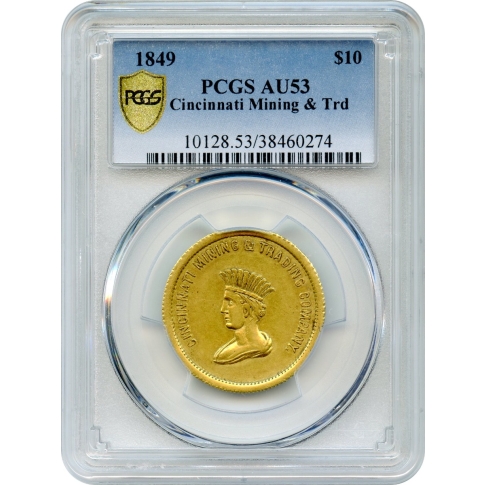1849 $10 California Gold Eagle - Cincinnati Mining & Trading PCGS AU53
1849 Cincinnati Mining & Trading Company. $10. Reeded edge. Very pale yellow gold in color with some faint traces of original mint lustre in some of the protected areas. No important marks requiring specific mention. Not overstruck. Struck from a perfect obverse die but a fatally broken reverse, the die with five different breaks running into the center from the rim. It is clear that one reason why these are so rare is that the reverse could not have struck very many before it broke apart. An extraordinary rarity. Ex. John Ford sale, 2004. At that time, the cataloguer stated they could trace just four examples: this; Garrett:885 (257.6 gns.); Brand II:1539 (overstruck on a J.S. Ormsby $10, 256.7 gns.); two pieces in the Smithsonian, one ex Mint, the other ex Lilly, both with reeded edges (there is no plain edge specimen in the Smithsonian and so Breen 7774 and Kagin 2 should both be delisted). Edgar H. Adams knew of three specimens in 1909 but by 1912 he could list four: one in the Mint cabinet, the piece Brand owned that was struck over a JSO, Garrett's which he knew was ex Zabriskie, and another one Brand had exhibited at the June, 1908 meeting of the Chicago Numismatic Society. Virgil Brand owned three specimens in 1920 (the presently offered Jacob Fishel piece, the JSO overstrike, and a third). Unaccountably, Breen listed only three known in 1988 although the Brand II cataloguer noted he knew of five in 1984. The Cincinnati Mining & Trading Company $10 is the only gold issue of this maker that is at all collectable, since the $5 is unique. There could not have been very many made to begin with since this firm was very short lived. It is believed that the firm's coins were actually struck by Broderick & Kohler in San Francisco between August and December, 1849. The fineness of the pieces was subpar, however, and the majority of those struck were probably melted during the course of their circulation lives. The ones we know of, today, were most likely saved as souvenirs. Breen wrote, correctly, that "Survivors are so rare that grade is irrelevant.'' As if to underline this statement, we note that when the Mint received a Cincinnati Mining & Trading Company $5 in 1851 it was decided not to assay the coin 'on account of their rarity.'' This coin has an unbroken pedigree back to the very firm that made it. When Brand bought the presently offered coin from Jacob Fishel in 1908, he paid $1,750 for it, the highest price he had paid for any coin up to then. Fishel told Brand that he was actually a descendant of one of the members of the Cincinnati Mining & Trading Company. Struck from the broken state of the reverse, in about the same degree as the Garrett and Brand II coins. The ex Mint Collection piece is severely broken into six distinct segments.
CINCINNATI MINING & TRADING
Only a month after President James Polk confirmed reports of a gold discovery in California on December 5, 1848, a group of 50 well-financed individuals formed the California Mining and Trading Company of Cincinnati. Each member was required to deposit $500 for the equipment and travel expenses to California, as well as two years worth of provisions once they gained access to the gold fields. According to the Cincinnati Gazette newspaper, the Cincinnati Company got aboard the steamer Bay State headed down the Ohio River. According to Edgar H. Adams, the company disembarked in St. Louis and then proceeded overland. Several months later the newspaper The New York Tribune received an accounting from a member of an undisclosed overland company referring to Cincinnati adventurers with "coining Apparatus." This notice was sent from Fort Childs, Missouri, 300 miles west of Independence. Adams believed this account referred to the Cincinnati Company.
Once in California, most of the original company must have preoccupied themselves with mining. Less than ten Cincinnati Mining and Trading coins exist today in either the known $5 or the $10 denominations. Three of these, including the unique $5, the unique $10 with a Plain Edge and one of the five known $10 Reeded Edge examples are permanently impounded in the Smithsonian Collection. One example of the latter exists struck over an Ormsby $10 gold piece, a Private gold coin which is today, a rarity in itself. The remaining three coins are presently in private collections, except for the present specimen.
EAGLE
Obverse: Similar to the Half Eagle. CINCINNATI MINING & TRADING COMPANY is above and surrounds the bust of a draped bust Indian featured in a feathered headdress. This coin was struck with a Reeded Edge (K-3, B-7773) and a Plain Edge. The Plain Edge coin is most likely Unique. (K-2, B-7774)
Reverse: CALIFORNIA TEN DOLLARS is above and surrounds an eagle preparing for flight with wings raised. A shield is before the eagle's breast while an olive branch and three arrows are held in its talons. The date 1849 appears below.
| PCGS # | 10128 |
|---|---|
| Grading Service | NONE |
| Year of Issue | NONE |
| Grade | NONE |
| Denom Type | N/A |
| Numeric Denomination | $10 |
| Mint Location | NONE |
| Designation | NONE |
| Circ/UnCirc | Not Specified |
| Strike Type | N/A |
| Holder Variety | Cincinnati Mining & Trading Company |
| Grade Add On | NONE |
| Holder Type | N/A |



